Organisms Reproductive and Population - Population Interaction | 12th Zoology : Chapter 11 : Organisms Reproductive and Population
Chapter: 12th Zoology : Chapter 11 : Organisms Reproductive and Population
Population Interaction
Population Interaction
Organisms belonging to different populations
interact for food, shelter, mating or for other necessities. Interaction may be
intra specific (interaction within the members of same species) or inter
specific (among organisms of different species).
Intra specific association is observed for all
livelihood processes like feeding, territoriality, breeding and protection.
Interspecific associations or interactions can
be:
Neutral: where different species live together but
do not affect each other.
Positive: it is a symbiotic relationship in which no
organism in association is harmed and either one or both may be benefitted. It
is of two types – Mutualism and Commensalism.
Negative: One or both of the interacting organisms
will be affected as in case of competition, predation, parasitism.
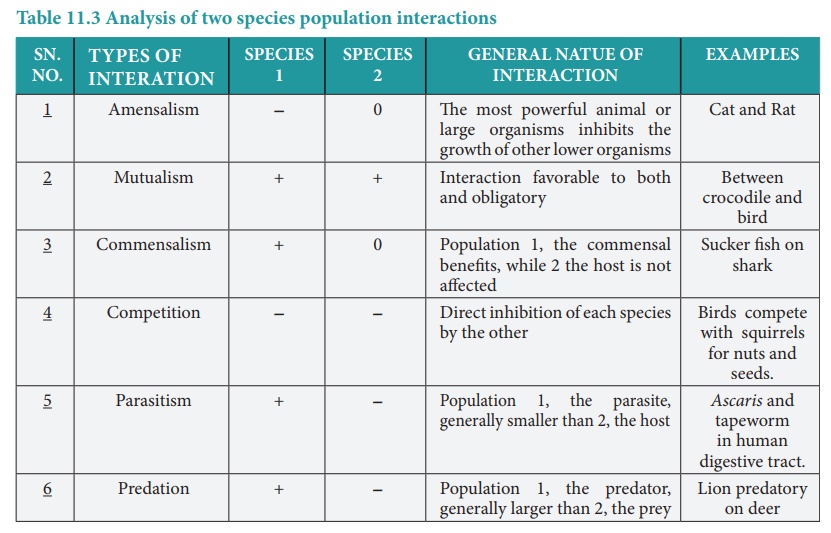
The common types of interspecific inter actions
are:
AMENSALISM (--, 0): This is the ecological
interaction in which an individiual species harm another without obtaining
benefit, large powerful animals harm weak animals. eg., animals destroyed at
the feet of elephants
MUTUALISM (+, +): It is the type of
interaction where both species benefit from the interaction. Mutualism may be
facultative when the species involved are capable of existence independent of
one another, or obligate, when the relationship is imperative of the existence
of one or both species. Examples:
• Certain bacteria in the caeca and intestine of
herbivores aid in the digestion of cellulose. In return the host provides
suitable environment for the growth of the bacteria.
• The cross pollination of flowers by insects
and birds seeking nectar and pollen which is of great importance in
agriculture.
• Small birds cleaning the teeth of crocodiles. Here the birds gets food and the teeth of crocodile is cleaned.
• The hermit crab carries along on its shell a
Sea anemone (a sedentary coelenterate). The crab is protected from its enemies
by the stinging cells of the anemone while the anemone gets its food (Fig.
11.15).
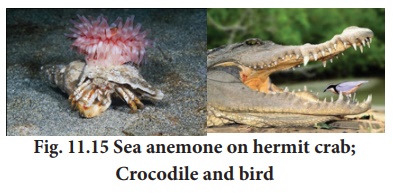
COMMENSALISM (+, 0): This defines the interaction
in which two or more species are mutually associated in activities centering on
food and one species at least, derives benefit from the association while the
other associates are neither benefited nor harmed. The concept of commensalism
has been broadened in recent years, to apply to coactions other than those
centering on food such as cover, support, production, and locomotion. Examples:
• Barnacles attached to Whales travel thousands
of miles collecting and filtering food from the moving water. The whales are
not affected by the barnacles.
• Egrets usually are present near cattle. They
catch insects which are disturbed by the cattle. The bird benefits, while the
cattles are not affected (Fig. 11.16).
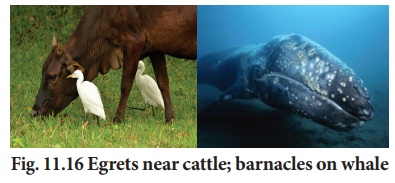
COMPETITION (--, --): It refers to the type of
interaction in which individuals of a species or members of different
species vie for limited availability of food, water, nesting space, cover,
mates or other resources. When resources are in more than adequate to meet the
demands of the organisms seeking them, competition does not occur, but when
inadequate to satisfy the need of the organisms seeking them, the weakest,
least adapted, or least aggressive individuals are often forced to face
challenges. This phenomenon is known as the competitive exclusion
principle of Hardin.
DEGREE OF COMPETITION - Competition is
usually keen between individuals of the same species (intraspecific
competition) because they have identical requirements for food, mates, and so
on. Interspecific competition occurs where different species require at least
some resource materials or conditions in common. The severity of competition
depends on the extent of similarity or overlap in the requirements of different
individuals and the shortage of the supply in the habitat as birds compete with
squirrels for nuts, and seeds; insects and ungulates compete for food in
grasslands (Fig. 11.17).
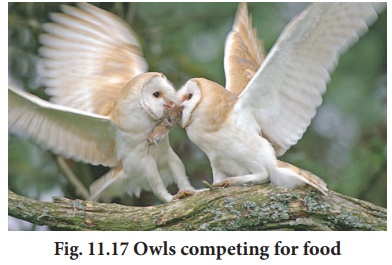
PARASITISM (+, --): It is a kind of harmful
interaction between two species, wherein one species is the ‘parasite’ and
the other its ‘host’. The parasite benefits at the expense of the host. A
parasite derives shelter, food and protection from the host. Parasites exhibit
adaptations to exploit their hosts. The parasites may be viral parasites (plant
animal viruses), microbial parasites (e.g., bacteria / protozoa / fungi), phytoparasites
(plant parasites) and zooparasites (animal parasites such as Platyhelminthes,
nematodes, arthropods). Parasites may inhabit or attach to the surface of the
host (Ectoparasites - Head lice, Leech) or live within the body of the host
(endoparasites – ascaris, tapeworm). The endoparasites usually live in the
alimentary tract, body cavities, various organs or blood or other tissues of
the host.
Parasites may be permanent or temporary.
Temporary parasites spend only a part of their life cycle as parasites. For
example, Glochidium larva of Anadonia (fresh water mussel) attaches
itself to the body of fish. Permanent parasites spend their life completely
dependent on their host organism. The common examples of permanent parasites
are Plasmodium, Entamoeba, Round worms, Pin worms, Tape worms,
etc.,
PREDATION (+, --): It is a form of interaction, where one animal kills another animal for food. Like parasitism, predation is important in community dynamics, but both differ in the point that a predator tends to be larger than its prey, and it catches its prey from without, while a parasite is smaller than its host and consumes it from within.
By their hunting activities predators can be
regarded as specialized or generalized.
Specialized predators are those adapted to hunt
only a few specific species. Lion and deer exhibit predator – prey
relationship, where the Lion is the predator and the deer is the prey. This
type of interaction helps in the transfer of energy up the trophic levels and is
an essential strategy in population regulation (Fig. 11.18).
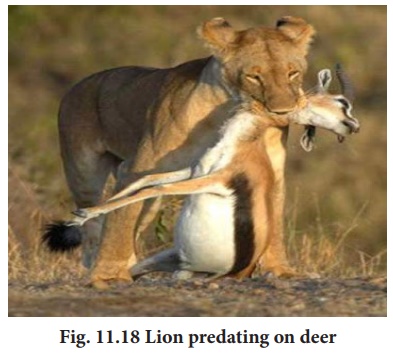
Related Topics